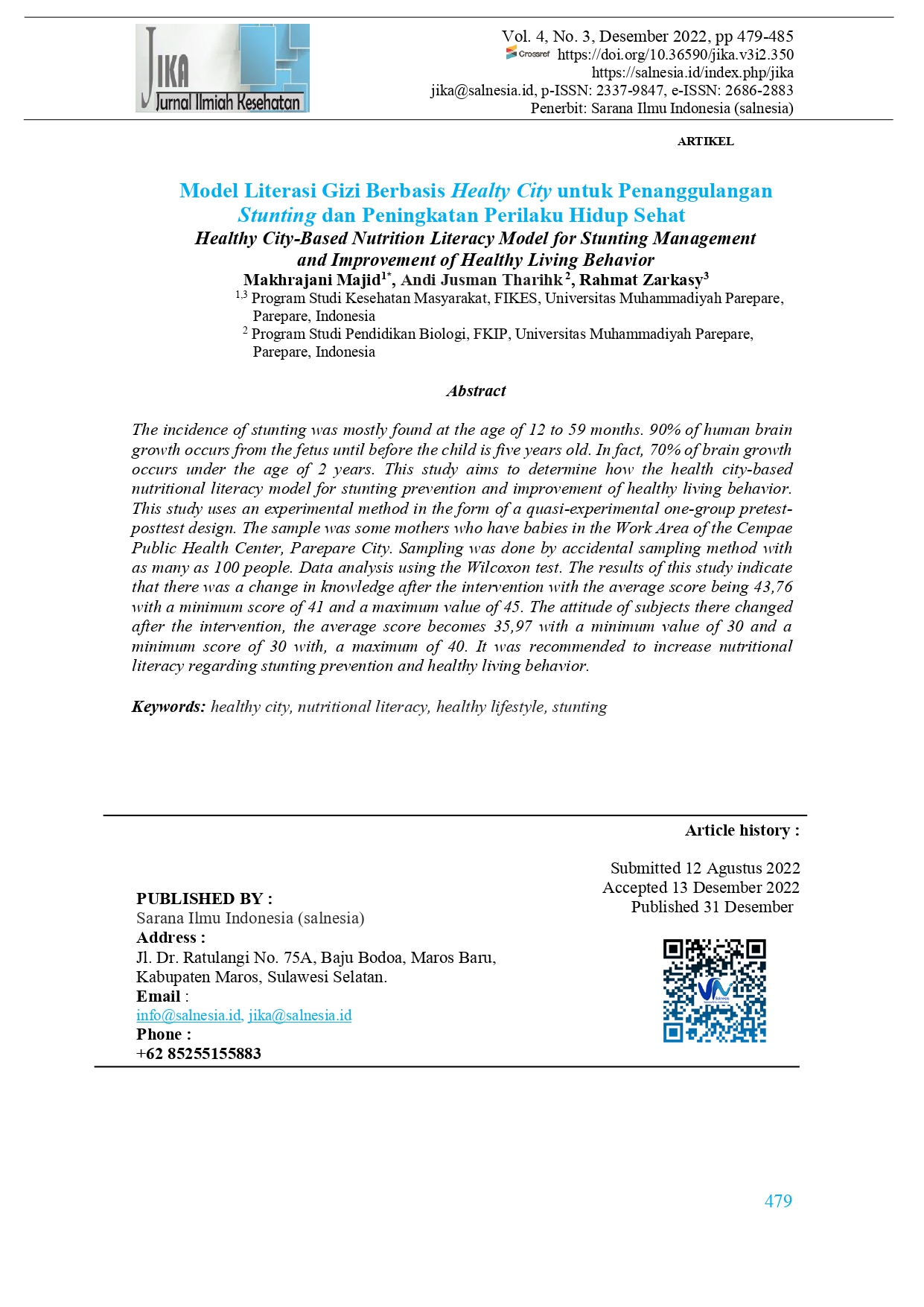Healthy City-Based Nutrition Literacy Model for Stunting Management and Improvement of Healthy Living Behavior
DOI:
https://doi.org/10.36590/jika.v4i3.350Keywords:
healthy city, nutritional literacy, healthy lifestyle, stuntingAbstract
The incidence of stunting was mostly found at the age of 12 to 59 months. 90% of human brain growth occurs from the fetus until before the child is five years old. In fact, 70% of brain growth occurs under the age of 2 years. This study aims to determine how the health city-based nutritional literacy model for stunting prevention and improvement of healthy living behavior. This study uses an experimental method in the form of a quasi-experimental one-group pretest-posttest design. The sample was some mothers who have babies in the Work Area of ??the Cempae Public Health Center, Parepare City. Sampling was done by accidental sampling method with as many as 100 people. Data analysis using the Wilcoxon test. The results of this study indicate that there was a change in knowledge after the intervention with the average score being 43,76 with a minimum score of 41 and a maximum value of 45. The attitude of subjects there changed after the intervention, the average score becomes 35,97 with a minimum value of 30 and a minimum score of 30 with, a maximum of 40. It was recommended to increase nutritional literacy regarding stunting prevention and healthy living behavior.
Downloads
References
Aryastami KI. 2017. Kajian Kebijakan dan Penanggulangan Masalah Gizi Stunting di Indonesia. Jurnal Buletin Penelitian Kesehatan, 45(4): 233–240.
Atica Ramadhani Putri. 2020. Aspek Pola Asuh, Pola Makan, dan Pendapatan Keluarga Pada Kejadian Stunting. Healty Tadulako Jurnal, 6(1).
Almatsier. 2013. Prinsip Dasar Ilmu Gizi. PT Gramedia Pustaka: Jakarta.
Fitriani, Ramlan, Rusman ADP. 2021. Efektivitas Kartu Cegah Stunting berpengaruh terhadap Pengetahuan Calon pengantin di KUA Kota Parepare. Jurnal Ilmiah Manusida dan Kesehatan, 4(3): 332-341.
Haerani. 2020. Literasi Kesehatan Cegah Stunting Kader Pemberdayaan Masyarakat di Kecamatan Bayongbong. [Artikel]. Repository uniga.ac.id.
Handayani I. 2020. Literasi gizi dorong upaya pencegahan stunting.
Mitra M. 2015. Permasalahan Anak Pendek (Stunting) dan Intervensi untuk Mencegah Terjadinya Stunting. Jurnal Kesehatan Komunitas, 2(6): 254–261.
Nurbaya. 2020. Investing in Nutrition Literacy to Reduce Stunting in Indonesia. Southeast Asian Magazine on Food and Nutrition. Jurnal Seameo Recfon Awesome.1(1):14-16.
Paramita, Shinta N. 2021. Hubungan Pengetahuan dan Sikap Ibu Mengenai Stunting. Community of Publishing in Nursing (Coping), 9(3): 323–331.
Puskesmas Cempae. Profil Puskesmas Cempae Tahun 2021. Parepare: Puskesmas Cempae
Pramulya Ika Sri, Wijayanti F, Saparwati M. 2021. Hubungan Pemberian Asi Eksklusif dengan Kejadian Stunting Pada Balita Usia 24-60 Bulan. Jurnal Kesehatan Kusuma Husada, 12(1):35-41.
Ridho MN, Sasongko RN, Kristiawan. 2021. Faktor-faktor yang Mempengaruhi Kejadian Stunting pada Anak Usia Dini di Indonesia. Jurnal Obsesi: Jurnal Pendidikan Anak Usia Dini, 5(2): 2269–2276.
Rokhmah D, Astuti NFW, Nurika G, Putra DNGWM, Khoiron. 2022. Pencegahan Stunting Melalui Penguatan Peran Kader Gizi dan Ibu Hamil Serta Ibu Menyusui Melalui Participatory Hygiene and Sanitation Transformation (PHAST). Pengabdian Masyarakat Bidang Sains dan Teknolog, 1(1): 74–80.
Ruswati R, Leksono AW, Prameswary DK, Pembajeng GS, Inayah I, Felix J, Dini, Ainan MS, Rahmadina N, Hadayna, Saila, Aprilia TR, Hermawati E, Ashanty A. 2021. Risiko Penyebab Kejadian Stunting pada Anak. Jurnal Pengabdian Kesehatan Masyarakat (Pengmaskesmas), 1(2): 34–38.
Suprapto H. 2021. Literasi Infomasi Kesehatan Bagi Ibu Rumah Tangga Sebagai Upaya Pencegahan Stunting. Jurnal Pengabdian Masyarakat, 2(2): 58–63.
Titaley CR, Ariawan I, Hapsari D, Muasyaroh A, Dibley MJ. 2019. Determinants of the stunting of children under two years old in Indonesia. A multilevel analysis of the 2013 Indonesia basic health survey. Nutrients, 11(5): 1106.

Downloads
Published
How to Cite
Issue
Section
License
Copyright (c) 2022 Makhrajani Majid, Andi Jusman Tharihk, Rahmat Zarkasy

This work is licensed under a Creative Commons Attribution 4.0 International License.








